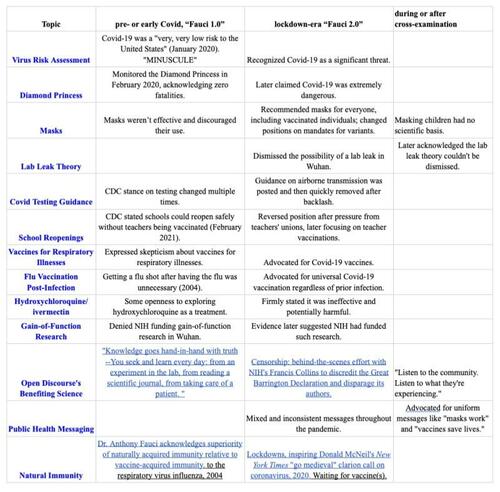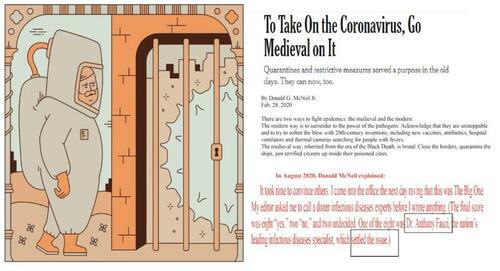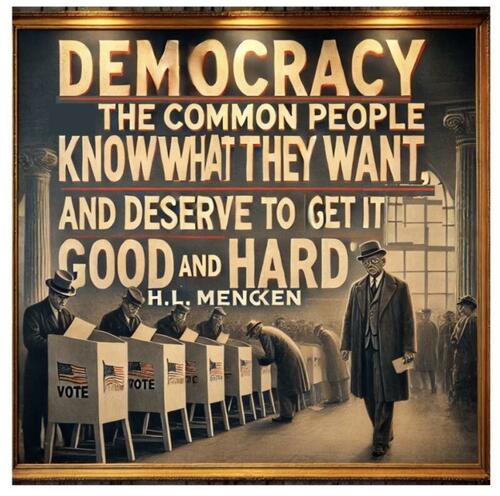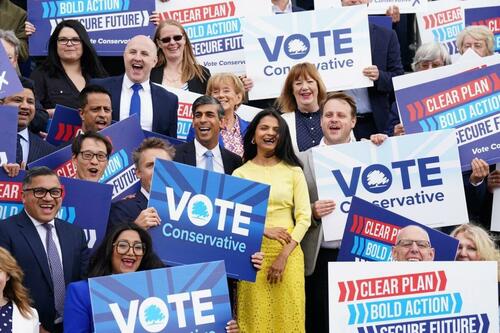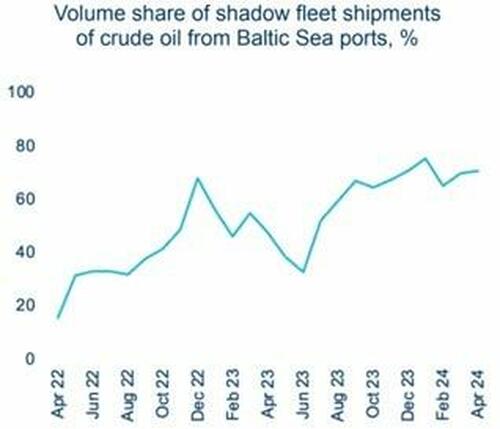
Fauci’s “DNA Of Caring” | ZeroHedge
Authored by Randall Block via The Brownstone Institute,
Dr. Anthony Fauci often claims a “DNA of caring” yet his actions reveal a stark contrast. Avoiding direct patient care, Dr. Fauci focused on populations—effecting a mindset aligned with abstract compassion for humanity that nonetheless neglects individual rights. His so-called ‘DNA of caring’ has most recently doubly stranded those subjected to it: first, by amplifying fear about Covid-19 while burying mitigating data; second, by pushing a vaccine in a draconian, methodical, and threatening manner, taking away liberty and jobs to an extreme never seen before in the history of mankind.
Additionally, by fast-tracking and strong-arming an mRNA vaccine-platform technology heretofore devoid of Phase II or III safety studies, Dr. Fauci prioritized hypothetical scientific advancement over actual current health, medical knowledge, and personal liberties—effectively double-crossing both the public’s trust and violating his own integrity: contradicting medically foundational principles he had spent his career enunciating—perhaps influenced by pharmaceutical interests.
Introduction: From Public Health to Panic: The Motivations Behind Dr. Fauci’s Pandemic Pivot
In early 2020, Dr. Anthony Fauci, Director of NIAID, initially approached the coronavirus with standard public health strategies. By late February, Dr. Fauci had become the deciding influencer for the New York Times’ Donald McNeil’s decision to go “up to eleven,” announcing: “To Take On the Coronavirus, Go Medieval on It.” This article heightened panic in New York City, soon to be America’s pandemic landfall—and marked a shift from a century of public health’s more measured responses BACKWARDS to draconian measures. Remember: “lockdowns” emanate literally from 1970s prisons.
Several theories potentially explain this pivot. One suggests Fauci’s involvement with NIAID grants to the Wuhan lab pushed him to deflect accountability. Another points to political motivations, aiming to undermine an adversary, Donald Trump—by destabilizing the economy, and influencing the election through lockdown-necessitated mail-in ballots.
A deeper, but not necessarily mutually exclusive motive may lie in Fauci’s support for mRNA vaccine technology. Previously, mRNA treatments had only reached Phase I trials. The pandemic allowed for emergency-use authorization, fast-tracking this experimental platform and breaking regulatory barriers—likely saving a decade by creating a precedent for future mRNA treatments. He did this knowing systemic vaccines may not be appropriate for respiratory illnesses, and having observed close hand China’s failure to create an effective Coronavirus vaccine in the 2000s after SARS.
And this wasn’t the first time: his persistence in pushing for mRNA technology was evident during the previous decade’s Zika Microcephaly pandemic response. Even as Zika had fizzled to zero (microcephaly-) cases, Fauci persisted in pushing for Zika (DNA-and mRNA-) vaccines. He dangled ~$100 million in front of Brazil in 2018, but it refused—whereupon he pivoted in the 2020s to Johns Hopkins to inject and infect women with Zika to test the vaccine. This is a man who will not let a public health emergency go to waste—even if it involves aggrandizing it.
Despite his self-assessment as having a “DNA of caring,” Fauci’s actions suggest a focus more on institutional goals and the advancement of mRNA technology than on the people themselves—via corporatism: merging governmental authority with big business interests. Treating populations with a one-size-fits-all approach, stripping away individual rights, and using people as means to societal ends evokes an antidemocratic utilitarianism.
A Self-Professed “DNA of Caring”
A Google search for “Dr. Anthony Fauci’s promotion of the mRNA vaccine” performed today (helpfully for the otherwise beleaguered Dr. Fauci) funnels towards his On Call: A Doctor’s Journey in Public Service book tour—including this ironic and self-titled fluff piece: ‘I had that DNA of caring for people‘ sweetly afforded by PBS’ uncritical, team player Geoff Bennett.
Nearly comically—this June 2024 video, intending to polish his legacy, inadvertently highlights his dictatorial tendencies, tin ear, and inability to learn from mistakes. Despite his mea culpa about failing to listen to stakeholders during the 1980s’ HIV/AIDS crisis and promising to have learned from that experience, merely a few sentences later Fauci lashes out at his contemporary Covid-19 critics.
The irony here is stark. Fauci admits that he and his institutions were domineering and unheeding of criticism during the HIV/AIDS crisis—whereupon he retroactively wishes he had given those activists input into the process that had so directly affected them.
DR. ANTHONY FAUCI: Understandably, but unacceptably, the scientific community and the regulatory community just said, “We know best for you. We’re the scientists. We’re the ones with the experience.” And they kept saying, “No, no, no. We really want a seat at the table.” When we didn’t listen, then they started becoming theatrical, iconoclastic, disruptive, and confrontative. As John Lewis used to say, ‘there’s trouble and there’s good trouble.’ They were making ‘good trouble’ in the field of health in wanting to have a seat at the table. One of the best things I think I have done in my career was to put aside the theatrics (note: an admission against interest) and listen to what they were saying, because what they were saying made absolutely perfect sense. And I remember saying to myself that, if I were in their shoes, I’d be doing exactly what they were doing.
GEOFF BENNETT: When you describe that (HIV/AIDS) experience as “enlightening,” how did it inform your approach moving forward to confront other epidemics?
DR. ANTHONY FAUCI: Yes. Yes, listen to the patients. Listen. And don’t think that everything comes from the top down. Listen to the community. Listen to what they’re experiencing. And you’re going to make a much better and more appropriate response to whatever the disease challenge is. That was a lesson that was very well-learned from the activists.
Volte-face and thin-skinned (a possible alternate title for his book), he shows no such sympathy for those who opposed his Covid-19 rabbit-out-of-a-hat absurdities, dismissing them outright:
DR. ANTHONY FAUCI: I think it’s important to say, because it’s the truth, that if ever there was a time when you didn’t want to have a public health crisis was at a time of profound divisiveness within our country, where you were having people making decisions about health based on political ideology. That is the worst possible circumstance.
It would have been really nice if we had a uniform message: “Masks work. Use them.” “Vaccines are good and save lives.” Let’s do it.
“No, hydroxychloroquine not only doesn’t work, but, in fact, it could harm you.” (ignoring risk/benefit ratio; “right to try,” FDA-approval, and track record—and that this is true for any treatment, cf. vaccines).
This dismissive attitude toward dissenting voices is ironic given Fauci’s complete 180 on his own views. He refuses to engage with anyone who challenges him, yet seems blissfully unaware he’s contradicting his past self. And there is this gem uncovered by the Select Subcommittee on the Coronavirus Pandemic from Dr. Fauci, Summer 2021—so different from his supposed HIV-lesson-learned to “Listen to the community. Listen to what they’re experiencing”—speaking more like a mob boss:
“I have to say that I don’t see a big solution, other than some sort of mandatory vaccination. I know federal officials don’t like to use that term. Once (administrators) feel empowered and protected legally, (they’ll) say, ‘you want to come to this college buddy, you’re going to get vaccinated.’ Yeah, big corporations are going to say ‘you want to work for us, you get vaccinated.’ And it’s been proven that when you make it difficult for people in their lives, they lose their ideological bullshit and they get vaccinated.”
Dr. Fauci’s actual “DNA of caring” is caring about pharmaceutical mRNA.
Fauci 1.0 Vs. Fauci 2.0
Somewhere around February 2020, there seems to have been a ‘software update’ of Dr. Fauci’s mindset, and not for the better. Generally speaking, people only turn to questionable behavior when faced with a greater agenda, threat to self, or conversion. Here’s a by-no-means complete table of Fauci Covid-era “flip-flops:”
This transformation was likely triggered by the realization of his agency NIAID’s and/or his own embarrassingly damaging complicity in the gain-of-function genesis of the “Wuhan flu” SARS-CoV-2 coronavirus threat. He aimed for self-preservation, politically maneuvering against Donald Trump to compromise him, while also greasing the skids for the mRNA vaccine.
This necessitated performing life support for the “emergency” in the “Emergency Use Authorization/ EUA” by quashing any interim medications, aggrandizing the threat of SARS-CoV-2—when he knew, from the Diamond Princess data, that it was not that severe (zero deaths, 25 days after exposure)—and backtracking from his comments that respiratory illnesses were not best approached by vaccines; that natural immunity was preferable to vaccine immunity, and that flu shots needed to be timely for the upcoming variant. Despite his previously calling the coronavirus threat “minuscule,” Fauci’s actions followed a pattern of (mis)using the crisis to bequeath a Big Science/Big Pharma (-regulatory-capture cycle untested mRNA treatments.
Covid-19 Pandemic: Overreach and Ignoring Early Data
During the Covid-19 pandemic, Fauci’s approach starkly contradicted the lessons he claimed to have learned from the HIV/AIDS crisis. He enforced top-down measures that often lacked scientific backing. For instance, he admitted in a January 2024 Congressional hearing (belatedly released in June) that he did not know the scientific basis for the six-foot social distancing rule and could not substantiate masking requirements for children.
“Collectively, the four pillars of the “Covidian Cult” were lockdowns, masks, social distancing and mRNA vaccines. Dr Fauci was one of the most powerful advocates of all of these things, and he became the public face of each demand. But here we have one of the architects, without too much pushing, admitting that two of those four pillars were never set in any scientific foundation at all. Now what this admission does is utterly destroy the entire Covidian argument. Because the argument was that we should “Follow the Science.” The argument was that technocratic experts had decided the course of action to follow, and that we had no right to question that course because they were the experts and we were simply, “Tracy from Facebook.” Daniel Jupp “Fauci’s Evidence: It just sort of appeared. You know, from nowhere.”
Fauci’s stance on vaccination mandates was equally inconsistent. In 2004, he advised against flu vaccines for those who had already contracted the flu. Yet during the Covid-19 pandemic, he supported mandatory vaccinations regardless of prior infection, ignoring the virus’ evolving nature. Vaccines were administered for an outdated strain, akin to giving expired flu shots, which are typically removed from circulation once the virus mutates significantly. This inconsistency highlighted his failure to adapt his policies to the realities of the virus’ mutations.
Fauci 1.0 had said, “You seek and learn…from an experiment“ (2005). The floating coronavirus-incubation/quarantine experiment, a.k.a. Diamond Princess was an incredible serendipity for the world—if not its 3,711 captives. Trying to enlist that number of people for an unknown viral threat would’ve required a pre-payout of ~$10 billion (and could not have included this random selection of individuals)—yet, the world was the beneficiary of this experiment in a timely fashion, February 2020 for “free” (although the passengers and crew might disagree with that term).
Instead of focusing on the obvious good news results: zero fatalities after three weeks’ exposure; essentially none of the children or young adults feeling much ill or even noticing infection—Fauci 2.0 sided with Chinese propaganda and extreme measures, contributing to widespread panic and economic devastation. Fauci 2.0 ignored the possibility of Chinese guile, either blithely or willfully—but in either case to our nation’s discredit, discomfort, disunion, and disinformation.
The Gates Foundation’s mRNA Finesse; Zika Emergency
In 2017, the Bill & Melinda Gates Foundation pledged $100 million to Moderna to develop an mRNA-platform vaccine for Zika. This investment was made despite the fact that Zika, a relatively harmless dengue variant, was not (by that time) persistently linked to the microcephaly cases it was blamed for. The Zika-microcephaly phenomenon just petered out even in the initial “pandemic” panic crisis year of 2016. This rush to develop an mRNA vaccine for a non-crisis reflects a broader trend of aggrandizing potential threats to justify rapid and untested vaccine development.
My book, Overturning Zika: The Pandemic That Never Was, points out the complete absence of any Zika-related microcephaly increase in any year, including the incipient 2015 year. Once Zika tests were developed and Brazil adopted the WHO standard for statistical microcephaly determination, the link between Zika and microcephaly was never substantiated—and effectively disappeared. “Zika-Microcephaly” had always and only been “science” by press release, political pressure, and professorial self-aggrandizement.
Dr. Fauci never stopped pushing for Zika vaccines long after it was clear there was no recurrence of Zika-related microcephaly in Latin America. In 2018, he attempted to initiate a human challenge trial (HCT) in Brazil, but the authorities refused, not wanting to introduce the Zika virus into the population through experimentation.
HCTs had fallen out of favor due to the negative outcomes of the Guatemala and Tuskegee experiments. In 2017, the NIH’s ethics panel determined that Zika did not warrant human challenge trials, but Dr. Fauci pushed for them regardless, ignoring prevailing public health wisdom.
Why was he jonesing for a putative Zika vaccine? Fauci was a proponent of synthetic vaccinology and mRNA platforms. Conveniently ignoring Zika-Microcephaly’s fizzle, he continued over-generously funding Moderna (whose very name is a portmanteau of “modified RNA”).
When Zika’s shoddy underlying science and non-recurrence failed to sustain the necessary “emergency” for mRNA technology, an unrepentant and unpunished Fauci aggrandized Covid-19 to achieve the same goals. Had he been reprimanded for violating the NIH ethics panel’s decision, he might not have been so rash and brash in exaggerating Covid-19. It appears Fauci pursued his “fix” of stealthily introducing mRNA technology to the public and mainstreaming it through vaccines, despite the ethical breaches and potential risks involved.
mRNA Vaccines: From Never Done to Pandemic Panacea
The foundation for mRNA-vaccine technology was laid years before the pandemic. Here’s an excellent history (behind paywall) of the endeavor, beginning with Robert F. Malone’s late-1980s conceptualization—although (reminiscent of Breaking Bad’s Gray Matter Technologies: Walter White says, “It was my hard work. My research. And you and Elliott made millions off it.”) all of the financial-windfall beneficiaries currently in the field are happy to orphan whistleblower Malone who said the coronavirus “should never have been politicized.” Legacy media is happy to help discredit him: effectively always, his name is accompanied by the term, “spreading misinformation.”
The Obama Administration invested heavily in mRNA research through DARPA (via the mysterious network, “JASON”) and BARDA. By the end of the Obama era, mRNA vaccines were being tested in both animals and humans – but never beyond Phase 1.
The Covid-19 pandemic fast-tracked the push for mRNA vaccines under Operation Warp Speed, prioritizing them over traditional vaccines like Johnson & Johnson’s adenovirus vector vaccine. Concerns about side effects, such as myocarditis in young males, were brushed aside in the rush to advance mRNA technology. This urgency overshadowed the critical need for proper safety trials, effectively using the public as guinea pigs in a massive, premature experiment.
Now, with the ice broken, a flood of new mRNA vaccines is in the pipeline for diseases like cytomegalovirus (CMV), influenza, and respiratory syncytial virus (RSV). Researchers are even exploring mRNA vaccines for avian flu, hepatitis C, HIV, and more. This rapid adoption bypasses decades of proven safety from traditional vaccine platforms, raising ethical concerns about using the global population for untested innovations.
Even if mRNA vaccines prove beneficial in the long run, we deserve better than to be test subjects in this grand experiment—without getting a share of the proceeds. It’s like “My parents went to Vegas and all I got was this lousy T-shirt,” but with much higher stakes.
Profit over Safety
The profit motive may be king. Much as the ‘minor issues’ of people’s freedoms and safety (I’m joking) were completely ignored to help speed the development of mRNA vaccines, being politically favored has its benefits. Every accommodation is made for electric vehicles or climate change initiatives. One wonders, given that everyone turned a blind eye to safety and is still doing so regarding Covid’s mRNA vaccine(s), whether these newer possibilities—which are not emergencies per se—will go through proper multiphase studies over the proper length of time to check for long-term side effects.
Studies for “long-term effects” ipso facto need a “long-term” study: eight or 10 years may not even be enough. Other vaccines have been out for decades and there are still questions circulating given that they are being given more frequently and with multiple other vaccines in combination throughout the course of tender childhood.
Pre-NCVIA (1986 federal liability waiver for vaccine manufacturers), kids got a handful of vaccines, now we are up to 72 separate inoculations recommended through adolescence. With whispers of avian flu and other potential “emergencies,” we have to be careful that these aren’t just efforts to fan the flames and bypass safety studies once again.
The silver lining, the promise we are given is that mRNA technology may help cancer treatment, food- and environmental- allergies, genetic diseases, heart disease, stroke, heart failure, and neurodevelopmental disorders. While these advancements are promising, it is essential to balance innovation with rigorous safety protocols; to balance self-interested Big Science/Big Pharma claims with the normal skepticism, given the track record.
Lockdowns: Misguided Anachronism
Fauci’s advocacy for lockdowns was another significant departure from standard public health practices. Historically, “lockdown” was a term used exclusively in prison settings. Before Covid-19, general population lockdowns were virtually unheard of, except in extreme cases like a tuberculosis outbreak in a South African prison and limited restrictions during the Ebola outbreak in Sierra Leone. Implementing such measures for Covid-19 ignored the relatively benign nature of the virus for most of the population. The lockdowns caused widespread economic disruption, halted education, and inflicted severe mental health consequences.
Donald McNeil of the New York Times famously espoused a “go medieval” approach to the virus, but only after the endorsement specifically of Dr. Fauci. McNeil’s article, “To Take On The Coronavirus, Go Medieval on It,” drummed up enormous fear and overreaction. In August 2020, McNeil revealed that his consultation with Dr. Fauci was pivotal in shaping the article.
Donald McNeil wrote:
“There are two ways to fight epidemics: the medieval and the modern. The modern way is to surrender to the power of the pathogens: Acknowledge that they are unstoppable and try to soften the blow with 20th-century inventions, including new vaccines, antibiotics, hospital ventilators and thermal cameras searching for people with fevers. The medieval way, inherited from the era of the Black Death, is brutal: Close the borders, quarantine the ships, pen terrified citizens up inside their poisoned cities.”
Mr. McNeil, writer and rhetorician (and decidedly not a scientist) is merely channeling this Fauci 2.0 bureaucrat/autocrat whose decidedly medieval methods fall into stark contrast with (erstwhile) modern public health’s. Fauci 2.0 essentially settled the issue for McNeil, who readily adopted this extreme stance.
Ironically, those advocating for a more modern public health approach, like the (genuine) experts behind the Great Barrington Declaration, were shut down. Fauci’s supposed “DNA of caring” seems to only extend to himself, his views, and his control over the narrative. His actions during Covid-19 show that he learned nothing from his self-professed enlightenment during the HIV/AIDS crisis.
He ignored and dismissed any criticism, especially from those on or above his level. Dr. Jay Bhattacharya, MD, PhD, (economics), for example, is arguably more qualified than Fauci, more of a political than medical ace. This is evident in his absurdly anachronistic “medieval” approach to the pandemic; his inability to tolerate dissent; his failure to listen to those who challenge him—in fact his censoring them, codifying a policy of “Shut Up!” to skeptics of his overreaching policies.
Even Fauci 1.0 was not a great medical doctor. In the 1980s, during the HIV/AIDS crisis, Fauci speculated that close household contact, without sexual interaction or needle sharing, could lead to AIDS transmission. This glib and unfounded claim led to widespread fear and misinformation. As a result, AIDS patients (it is posited) were often abandoned by their families due to the fear of casual transmission.
His stubborn focus on producing a vaccine rather than therapeutics was of particular frustration to activists and other scientists. Ironically, this emphasis on vaccines over therapeutics repeated in 2020 and 2021 with the push for mRNA vaccines, despite the availability of other potential treatments.
The government, under Fauci’s influence, went out of its way to insult and ridicule FDA-approved, off-label usage, rational treatment alternatives, such as hydroxychloroquine (HCQ) and Nobel-Prize generating ivermectin (which was FALSELY derided as mere horse medication). Many drugs used in humans are also used in animals. This dismissal and ridicule were strategic, aimed at maintaining the narrative that only a vaccine could solve the crisis, thus justifying the emergency use authorization (EUA) for the mRNA vaccines. Absent an emergency, they would not have been able to circumvent the necessary safety measures. This strategy was not only misleading but potentially criminal, as it prioritized the adoption of untested vaccines over exploring all possible treatment avenues.
Unprecedented Excess Deaths
The implications of these decisions have been far-reaching and devastating. According to researchers from Vrije Universiteit, Amsterdam, there have been more than three million excess deaths since 2020, with the trend continuing despite (or because of) the rollout of vaccines and containment measures. In BMJ Public Health, the authors stated,
“excess mortality has remained high in the Western World for three consecutive years, despite the implementation of COVID-19 containment measures and COVID-19 vaccines. This is unprecedented and raises serious concerns. During the pandemic, politicians and the media emphasized daily that every COVID-19 death mattered and every life deserved protection through containment measures and COVID-19 vaccines. In the aftermath of the pandemic, the same morale should apply.”
This is the tragic outcome of Fauci’s policies. The world was promised salvation, but instead, we have worse economies, more top-down nondemocratic management, halted education, and disrupted lives. Children couldn’t see people’s faces, and the societal impacts have been profound.
We Were Betrayed by Falsehoods
Dr. Anthony Fauci’s actions during the Covid-19 pandemic mirrored the very failings he claimed to have learned from the HIV/AIDS crisis. His inability to adapt, combined with a penchant for authoritarian measures, has left a legacy of distrust and division. Fauci’s enforcement of arbitrary measures, disregard for scientific data, and contribution to economic and social disruption have caused untold harm. His tenure stands as a stark reminder of the dangers of unchecked authority.
Fauci’s role in the Covid-19 response has shown a disregard for American values of liberty and openness. His actions have inflicted deep scars on the nation, from economic devastation to the erosion of public trust. The world deserves better from its public health leaders, and Fauci’s tenure stands as a cautionary tale of what happens when power goes unchecked. The suffering caused by his decisions is a legacy not of public health triumph but of public health failure and manipulation.
As H.L. Mencken famously said, “Democracy is the theory that the common people know what they want, and deserve to get it good and hard.” Unelected Dr. Fauci’s prison-styled lockdowns and tyrannical, unproven, mRNA-over-vaccinating within an overall disdainful, peremptory medical misgovernance made sure of that.
Loading…
Originally Posted at; https://www.zerohedge.com//
Stay Updated with news.freeptomaineradio.com’s Daily Newsletter
Stay informed! Subscribe to our daily newsletter to receive updates on our latest blog posts directly in your inbox. Don’t let important information get buried by big tech.
Current subscribers:


